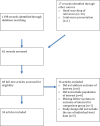Outreach and integration programs to promote family planning in the extended postpartum period
- PMID: 24434229
- PMCID: PMC4040294
- DOI: 10.1016/j.ijgo.2013.09.021
Outreach and integration programs to promote family planning in the extended postpartum period
Abstract
Background: WHO recommends birth spacing to improve the health of the mother and child. One strategy to facilitate birth spacing is to improve the use of family planning during the first year postpartum.
Objectives: To determine from the literature the effectiveness of postpartum family-planning programs and to identify research gaps.
Search strategy: PubMed and the Cochrane Central Register of Controlled Trials were systematically searched for articles published between database inception and March 2013. Abstracts of conference presentations, dissertations, and unpublished studies were also considered.
Selection criteria: Published studies with birth spacing or contraceptive use outcomes were included.
Data collection and analysis: Standard abstract forms and the US Preventive Services Task Force grading system were used to summarize and assess the quality of the evidence.
Main results: Thirty-four studies were included. Prenatal care, home visitation programs, and educational interventions were associated with improved family-planning outcomes, but should be further studied in low-resource settings. Mother-infant care integration, multidisciplinary interventions, and cash transfer/microfinance interventions need further investigation.
Conclusions: Programmatic interventions may improve birth spacing and contraceptive uptake. Larger well-designed studies in international settings are needed to determine the most effective ways to deliver family-planning interventions.
Keywords: Birth spacing; Family planning; Postpartum period; Programmatic interventions; Rapid repeat birth; Systematic review; Teen pregnancy.
Copyright © 2013 International Federation of Gynecology and Obstetrics. Published by Elsevier Ireland Ltd. All rights reserved.
Figures
Similar articles
-
Education for contraceptive use by women after childbirth.Cochrane Database Syst Rev. 2015 Jul 29;2015(7):CD001863. doi: 10.1002/14651858.CD001863.pub4. Cochrane Database Syst Rev. 2015. PMID: 26222129 Free PMC article.
-
Education for contraceptive use by women after childbirth.Cochrane Database Syst Rev. 2012 Aug 15;(8):CD001863. doi: 10.1002/14651858.CD001863.pub3. Cochrane Database Syst Rev. 2012. Update in: Cochrane Database Syst Rev. 2015 Jul 29;(7):CD001863. doi: 10.1002/14651858.CD001863.pub4. PMID: 22895923 Updated.
-
Education for contraceptive use by women after childbirth.Cochrane Database Syst Rev. 2002;(3):CD001863. doi: 10.1002/14651858.CD001863. Cochrane Database Syst Rev. 2002. Update in: Cochrane Database Syst Rev. 2010 Jan 20;(1):CD001863. doi: 10.1002/14651858.CD001863.pub2. PMID: 12137636 Updated.
-
Incentives for increasing prenatal care use by women in order to improve maternal and neonatal outcomes.Cochrane Database Syst Rev. 2015 Dec 15;2015(12):CD009916. doi: 10.1002/14651858.CD009916.pub2. Cochrane Database Syst Rev. 2015. PMID: 26671418 Free PMC article.
-
Education for contraceptive use by women after childbirth.Cochrane Database Syst Rev. 2010 Jan 20;(1):CD001863. doi: 10.1002/14651858.CD001863.pub2. Cochrane Database Syst Rev. 2010. Update in: Cochrane Database Syst Rev. 2012 Aug 15;(8):CD001863. doi: 10.1002/14651858.CD001863.pub3. PMID: 20091524 Updated.
Cited by
-
Effect of Package of Interventions on the Use and Quality of Postpartum Family Planning Services at Yekatit 12 Hospital Medical College (Y12HMC), Addis Ababa, Ethiopia.Health Serv Insights. 2023 Mar 10;16:11786329231160017. doi: 10.1177/11786329231160017. eCollection 2023. Health Serv Insights. 2023. PMID: 36923261 Free PMC article.
-
Predictors of Non-Attendance to the Postpartum Follow-up Visit.Matern Child Health J. 2016 Nov;20(Suppl 1):22-27. doi: 10.1007/s10995-016-2184-9. Matern Child Health J. 2016. PMID: 27562797
-
It's about time: WHO and partners release programming strategies for postpartum family planning.Glob Health Sci Pract. 2014 Feb 4;2(1):4-9. doi: 10.9745/GHSP-D-13-00156. eCollection 2014 Feb. Glob Health Sci Pract. 2014. PMID: 25276558 Free PMC article. Review.
-
Characteristics of successful integrated family planning and maternal and child health services: Findings from a mixed-method, descriptive evaluation.F1000Res. 2019 Feb 28;8:229. doi: 10.12688/f1000research.17208.2. eCollection 2019. F1000Res. 2019. PMID: 32047599 Free PMC article.
-
The state of postpartum contraceptive use in India: descriptive lessons from nationally representative survey data.Reprod Health. 2025 Mar 13;22(1):39. doi: 10.1186/s12978-025-01978-3. Reprod Health. 2025. PMID: 40075525 Free PMC article.
References
-
- Singh S, Darroch JE. Adding It Up: Costs and Benefits of Contraceptive Services. Estimates for 2012. http://www.unfpa.org/webdav/site/global/shared/documents/publications/20.... Published 2012.
-
- Borda M, Winfrey W. Postpartum Fertility and Contraception: An Analysis of Findings from 17 Countries. http://www.k4health.org/sites/default/files/Winfrey_Borda_17countryanaly.... Published March 2010.
-
- World Health Organization . Report of a WHO Technical Consultation on Birth Spacing. Geneva, Switzerland: Jun, 2005. pp. 13–15. http://www.who.int/maternal_child_adolescent/documents/birth_spacing.pdf. Published 2006.
-
- Harris RP, Helfand M, Woolf SH, Lohr KN, Mulrow CD, Teutsch SM, et al. Current methods of the US Preventive Services Task Force: a review of the process. Am J Prev Med. 2001;20(3 Suppl):21–35. - PubMed
Publication types
MeSH terms
Grants and funding
LinkOut - more resources
Full Text Sources
Other Literature Sources
Medical


